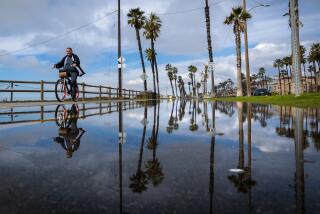Storm Kills Six, Inflicts Severe Damage in State
The latest storm to ram California killed at least six people, including two police officers and two college students, and swiped savagely at hillsides, highways and railroad tracks, scattering despair and destruction before blowing out of the state Tuesday.
At least one other person died and another was missing across the border in Tijuana in the 49th storm to hit that city this winter. The intense rainfall forced 550 people from their homes.
Another terrifying evacuation took place in the pitch-black, pouring rain in Laguna Beach, when a wall of mud roared down hillsides, killing one man and driving dozens of his neighbors to the only dry ground they could find.
“People were on top of their roofs, screaming for help,” said Denise Hibben.
“All of a sudden everyone started yelling ‘Get out! Get out! The mountain is coming down!’ ” said Eldon Setterholm, 74. “I ended up doing the breaststroke in the mud.”
Even as skies cleared Tuesday, somber scenes continued to play out across the state as residents tried to make sense of El Nino’s latest wallop.
Tragedy struck San Luis Obispo County when the raging Cuyama River changed course, gnawing a huge chunk out of a local highway outside Santa Maria.
Two veteran California Highway Patrol officers died about 2:30 a.m. Tuesday when their car toppled into the hole, falling at least 15 feet, flipping over and washing down the river about a quarter of a mile. Their colleagues speculated that Officers Britt T. Irvine, 40, and Rick B. Stovall, 39, might not even have seen the abyss in the early morning fog as they responded to a call of a big rig in distress along California 166.
“They were out doing what they are supposed to do. They were out helping the public,” said CHP Lt. Paul Matthies.
When the CHP’s Santa Maria command center lost contact with Irvine and Stovall about 2:45 a.m., a Santa Barbara County sheriff’s deputy was dispatched to investigate. He nearly died as well; his car had to be pulled to safety after the front wheels tipped into the sinkhole.
By the time rescue crews reached the scene, four vehicles had plunged into the sinkhole: the big rig, a pickup, an auto and the officers’ patrol car. The drivers of two of the vehicles were plucked to safety, both suffering from hypothermia and one in need of surgery for a scalp injury.
Authorities were trying to determine late Tuesday whether anyone else remained trapped in the muck.
In Malibu’s Las Flores Canyon, county fire officials called for the voluntary evacuation of about a dozen homes because of unstable ground.
As the river continued to chew into California 166--ripping away at the rock and dirt underlying the asphalt--about 125 rescuers toiled to reach the trapped vehicles and free the CHP officers’ bodies.
Among the storm’s other casualties were two 19-year-old sophomores at Pomona College who were killed on their way to class Monday night when a eucalyptus tree toppled over and slammed into their sports utility vehicle, crushing it.
“It was like it was aimed right at them,” said Jeremy Douglass, a junior who happened by the scene a few minutes later.
The victims, Brian G. Cressner of Los Angeles and Yuta P. Kurahashi of Los Altos in Northern California, were dorm mates known for opening their doors at all hours to friends who wanted to watch movies, trade jokes or just gab the night away. “They loved living,” said Eric Duggan, who played with Cressner on the Pomona-Pitzer soccer team.
Authorities also blamed the storm for a fatal collision on California 99 in the San Joaquin Valley. Flooding washed out a segment of the highway Tuesday, swamping it in so much water that officials said it could remain closed a week. Some stretches of the freeway were buried under 16 feet of water, and 200 people from the small farm town of Earlimart were evacuated.
“Highway 99 looks like a lake,” said Tulare County Sheriff’s Lt. Mike Gutsch. “Two underpasses are completely flooded . . . right up to the highway signs.”
The sixth fatality was recorded in Laguna Beach. Glenn Flook, 25, was killed by a mudslide so powerful that it pushed homes off their foundations and shoved cars out of their parking spots. Rescuers found Flook’s body buried in mud and pushed up against a house trailer.
Nine people were injured in the slide, including 9-month-old Tiffany Serabia, who survived thanks to a dramatic--and so far, anonymous--rescue during a chaotic emergency evacuation in the rain before dawn Tuesday.
Tiffany apparently flew out of her mother’s arms when the hillside behind her apartment gave way about midnight, tumbling down with such explosive force that it split the apartment in two and swept her family outside.
Somehow, a man saw the baby in the muck and was able to snag her amid a terrifying commotion.
“[The infant] was just a bundle of mud,” said Todd Tingsley, who grabbed the baby and carried her to safety after the unidentified rescuer shoved her in his arms. Tiffany was treated for minor cuts and bruises at a hospital and released.
While Tiffany’s rescue may well have been the most dramatic one, the Southland experienced several other close calls.
A tornado touched down in Huntington Beach. Another barreled into Long Beach, near Ultimo Avenue, with the fearsome screeching noise of a freight train’s whistle.
The Long Beach twister swatted a huge acacia tree right into Charles and Shirlee Ford’s roof. The tree--seven stories tall--missed their master bedroom by barely four feet. On the next street over, the tornado whipped hundreds of white pebbles off a roof into Eileen Anderson’s backyard. “It looked like it was covered in snow,” she said. “It was just a terrible experience.”
In Huntington Beach, the small tornado ripped awnings and skirtings from homes in the Huntington Mobile Estates at Slater Avenue and Beach Boulevard about 1:30 a.m. No injuries were reported, but an aluminum storage shed was blown into power lines, knocking out power in the area for two hours, authorities said.
In the high San Bernardino Mountains, 60-mph winds and fear of an avalanche prevented rescuers from approaching a small plane found buried up to its tail in the snow. Authorities were unable to confirm whether it was the plane reported missing Monday morning with two people aboard after taking off from Big Bear.
Elsewhere, the storm caused inconveniences large and small.
Every beach between Palos Verdes and the Ventura County line was closed due to sewage pouring out of overtaxed storm drains toward the ocean. Amtrak canceled service from San Diego to San Luis Obispo as rain washed out the tracks. In the Northern California community of Clear Lake, about 500 homes remained under a mandatory evacuation order as the lake rose to its highest level since 1909.
Deep snow forced at least temporary shutdowns on passes through the Sierra. Schools were closed in several communities, including Laguna Beach, Ventura and Port Hueneme, where major roadways were impassible.
In Malibu, more mudslides on Pacific Coast Highway forced officials to close the local courthouse. And in Ojai, 25 homeowners flooded out for the second time this winter shoveled silt from their driveways. “The whole creek has just blown over the yard,” said one glum Ojai resident, Dan Misiaszek, who figured that he sustained $10,000 in damages in the first flood and $5,000 this time.
“It’s mostly psychological now,” said 56-year-old Art Isgur, keeping a watchful eye on the horizon. “You see a cloud in the sky and you start shaking.”
Amid the gloom, there was some good news Tuesday: The state’s reservoirs and levee systems were holding up well, and meteorologists promised no more rain for at least a week. “Things look pretty nice,” said Wes Etheredge, a forecaster with WeatherData Inc.
But the cheery forecasts were of little consolation to commuters stranded by the lingering effects of the most recent storm.
For the first time since the El Nino season began, Amtrak had to shut down an entire line Tuesday: the 347 miles of track between San Diego and San Luis Obispo, which handle about 4,400 commuters a day, spokesman Dominick Albano said.
The northern half of that line, from Los Angeles through Ventura and Santa Barbara, will remain out of commission at least through March 9 while crews scramble to rebuild a washed-out bridge. The southern half of the line will reopen today, but passengers will have to transfer to a bus for part of the way.
Commuters heading north from Los Angeles cannot even switch to Metrolink: another rail washout canceled service to the Camarillo and Oxnard stations until further notice. The Simi Valley and Moorpark stations remained open.
Metrolink also shut down service today and Thursday to the Acton and Lancaster stations on the Antelope Valley line and the San Clemente, Oceanside and San Juan Capistrano stations on the Orange County line.
“We often say we’re a force to be reckoned with, so don’t mess with our trains, but when Mother Nature is involved, she appears to gain some ground on us,” said Metrolink spokesman Peter Hidalgo. “We can withstand earthquakes, no problem, but rains are definitely another story.”
Even before Monday’s deluge, this season’s El Nino-powered storms had caused about $475 million of damage in California. More than 8,000 residents statewide had requested assistance from the Federal Emergency Management Agency, and the state was seeking federal disaster status for Los Angeles and Orange counties.
Cities across the state were reporting record seasonal rainfall totals.
Through Monday afternoon, Santa Ana had tallied nearly 22 inches of rain this season, two and a half times the average for that city. San Francisco logged more than 38 inches--the most in a quarter of a century. The Los Angeles Civic Center also got soaked with twice its normal rainfall this winter, eclipsing a record set in 1992-3.
And despite the cheery predictions for this week, it’s not over yet.
Not by a long shot.
In a typical El Nino year, the atmosphere stabilizes--and skies over California brighten--by late spring, Etheredge said. But since this year’s El Nino condition is stronger than most, Etheredge said, “it’s very possible that [storm] conditions will persist into the early part of summer.”
* FORECASTERS VINDICATED: The series of intense, damaging storms with fatalities has proved skeptics wrong. A3
* POURING STRAIN: El Nino’s deluge is testing the fortitude and creativity of many Southland businesses. D1
Also contributing to this report were Times staff writers Fred Alvarez, Mark Arax, Nancy Cleeland, Mary Curtius, Marcida Dodson, Tom Gorman, Shelby Grad, Bonnie Hayes, Karima A. Haynes, Daryl Kelley, Joe Mozingo, Davan Maharaj, Scott Martelle, Tony Perry, Scott Reckard, Nicholas Riccardi, Julie Tamaki, Tracy Wilson and correspondents Deborah Belgum and Liz Seymour.
(BEGIN TEXT OF INFOBOX / INFOGRAPHIC)
Deadly Storm
At least seven deaths resulted from Monday’s El Nino-influenced storm, which spun off deadly mudslides, flooding and tornadoes. In Tijuana, one person died and four were missing after a car washed away. In the San Joaquin Valley, one person was killed in a flood-and-fog-related collision.
IN SOUTHERN CALIFORNIA
1) Two CHP officers die in a highway washout in San Luis Obispo County; unknown number of motorists missing
2) Two people die when tree falls on cars in Claremont
3) Mudslide in Laguna Beach kills one man
*
OTHER IMPACT:
4) Tornado in Huntington Beach
5) Tornado in Long Beach
6) In Ventura, Amtrak service halted till at least March 2 by damage to train trestle; hillside apartment building flattened by mudslide
ALSO: Plane disappears in San Bernardino Mountains near Big Bear Lake
More to Read
Sign up for Essential California
The most important California stories and recommendations in your inbox every morning.
You may occasionally receive promotional content from the Los Angeles Times.










